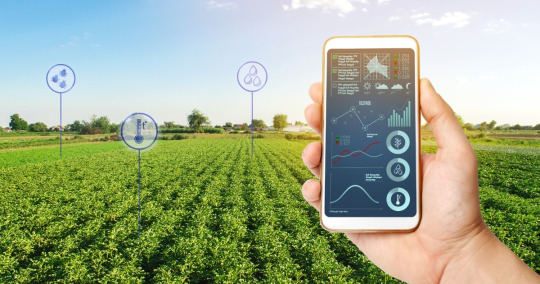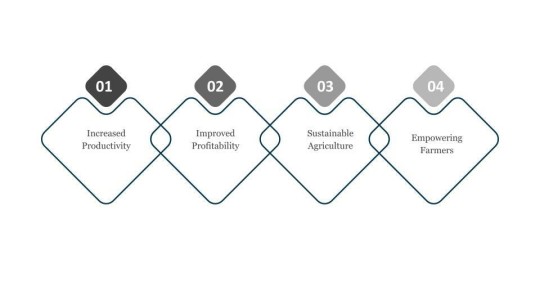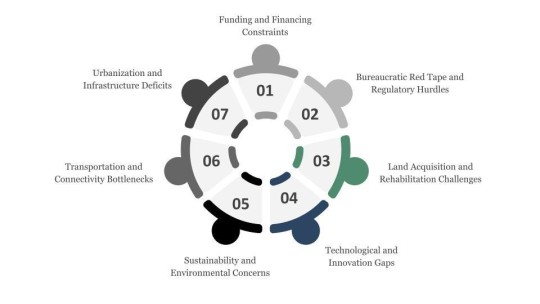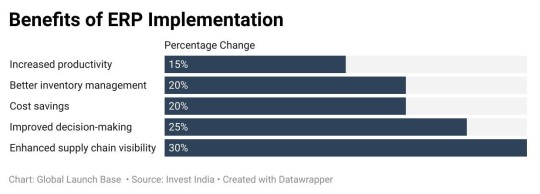#DigitalTransformationInFarming hashtag
Text
Agriculture ERP's Role in Unlocking Growth
Written By: Jagriti Shahi

Introduction
India, with its vast and diverse agricultural landscape, has been embracing technological advancements to modernize its farming practices. One such pivotal development is the implementation of Agriculture Enterprise Resource Planning (ERP) infrastructure. This integrated system is designed to streamline and optimize various agricultural processes, from production and supply chain management to financial transactions and data analysis. In this article, we will explore the significance and impact of Agriculture ERP infrastructure in India. India, a country deeply rooted in its agricultural heritage, is on the cusp of a transformative journey in farming practices, driven by technological advancements. At the heart of this evolution is the implementation of Agriculture Enterprise Resource Planning (ERP) infrastructure. This integrated system is not merely a digital tool but a comprehensive solution designed to revolutionize every facet of the agricultural supply chain. From the intricacies of crop planning to the intricacies of financial transactions, ERP infrastructure is reshaping the landscape of Indian agriculture. In this article, we delve into the significance, features, and profound impact of Agriculture ERP infrastructure in propelling India towards a future of sustainable and technologically-empowered farming.

Figure: Indian Agriculture Market Size - 2019 - 2023
India's agricultural sector, a cornerstone of the nation's economy, is undergoing a digital transformation. At the heart of this change lies Agriculture Enterprise Resource Planning (ERP) systems. But how ready is the current infrastructure for widespread ERP adoption, and how can ERP companies prepare for the unique landscape of Indian agriculture?
The Current Landscape: A Patchwork of Potential
India's agricultural infrastructure presents a complex picture. While some regions boast modern facilities and tech-savvy farmers, others struggle with limited internet connectivity, fragmented land holdings, and a lack of digital literacy. This digital divide creates a challenge for widespread ERP implementation.
However, there are reasons for optimism. Government initiatives like Digital India and Krishi Megh (Farmers' Cloud) are promoting digital literacy and rural internet connectivity. Additionally, the rise of affordable smartphones and mobile apps is bridging the gap for many farmers.

Figure: Adoption Rate of Agriculture ERP Systems Over Time
This figure indicates the percentage of agricultural businesses in India that have adopted ERP systems during each corresponding year.

Figure: Forecasted Growth of Agriculture ERP Market
The Need for Agriculture ERP in India
India's agriculture sector has traditionally been characterized by small-scale farming practices, fragmented land holdings, and manual labor. The introduction of ERP systems aims to address several challenges faced by the agricultural community, such as inefficient resource utilization, lack of real-time data, and limited access to market information. By leveraging technology, the Agriculture ERP infrastructure seeks to enhance productivity, increase efficiency, and ultimately boost the income of farmers.
Key Features of Agriculture ERP in India
Crop Planning and Management: ERP systems enable farmers to plan and manage their crops effectively by providing real-time data on weather conditions, soil health, and market demand.
Crop management modules assist in optimizing planting schedules, crop rotations, and resource allocation, leading to improved yield and reduced wastage.
Supply Chain Integration: Seamless integration of the supply chain is a critical component of Agriculture ERP. It facilitates efficient coordination between farmers, suppliers, distributors, and retailers.
Real-time tracking of produce from farm to market ensures transparency, reduces wastage, and minimizes losses during transportation.
Financial Management: ERP infrastructure helps farmers manage their finances by providing tools for budgeting, expense tracking, and revenue forecasting.
Access to credit facilities and insurance options is enhanced, empowering farmers to make informed financial decisions and mitigate risks.
Market Intelligence: The ERP system gathers and analyzes market data, enabling farmers to make informed decisions based on current market trends and demand.
Access to market intelligence helps farmers negotiate better prices and explore new markets for their produce.
Data Analytics and Precision Farming: Data analytics tools incorporated in Agriculture ERP systems enable farmers to make data-driven decisions.
Precision farming techniques, aided by ERP infrastructure, allow for optimized resource utilization, leading to increased efficiency and reduced environmental impact.
Benefits and Impact
Increased Productivity: By providing farmers with timely and relevant information, Agriculture ERP infrastructure contributes to enhanced productivity through optimized crop planning and resource utilization.
Improved Profitability: Efficient supply chain management, access to market information, and financial planning tools contribute to increased profitability for farmers.
Sustainable Agriculture: Precision farming practices promoted by ERP systems promote sustainable agriculture by minimizing resource wastage and environmental impact.
Empowering Farmers: Agriculture ERP infrastructure empowers farmers by providing them with the tools and knowledge to make informed decisions, access financial resources, and navigate the market effectively.

Challenges and Future Prospects While Agriculture ERP infrastructure holds immense potential, challenges such as the digital divide, infrastructure limitations, and resistance to technology adoption must be addressed. The government, private sector, and agricultural communities need to collaborate to overcome these hurdles and ensure the widespread adoption and success of ERP systems in Indian agriculture.
In conclusion, the implementation of Agriculture ERP infrastructure in India represents a significant step towards modernizing the agricultural sector. By leveraging technology to enhance efficiency, productivity, and sustainability, these systems play a crucial role in transforming traditional farming practices and improving the livelihoods of millions of farmers across the country. As India continues on its path of agricultural development, the integration of ERP infrastructure will remain a key driver of positive change in the sector.
Challenges of India's Infrastructure Landscape
India, as one of the world's fastest-growing economies, faces a myriad of challenges in its infrastructure development. Despite significant progress in recent decades, the country grapples with persistent obstacles that hinder the efficient functioning and expansion of its infrastructure networks. Understanding these challenges is crucial for policymakers, investors, and stakeholders to devise effective strategies for addressing them and unlocking India's full growth potential.
1. Funding and Financing Constraints: One of the primary challenges facing Indian infrastructure development is the availability of funding and financing. Infrastructure projects often require substantial capital investment, and securing long-term financing on favorable terms remains a significant hurdle. Issues such as regulatory uncertainties, project delays, and high debt burdens deter both domestic and foreign investors, constraining the pace of infrastructure expansion.
2. Bureaucratic Red Tape and Regulatory Hurdles: India's bureaucratic processes and regulatory frameworks are often cited as major impediments to infrastructure development. Cumbersome approval processes, overlapping jurisdictional authorities, and complex legal requirements contribute to project delays and cost overruns. Streamlining regulatory procedures, enhancing transparency, and promoting ease of doing business are essential for expediting infrastructure projects and attracting investment.
3. Land Acquisition and Rehabilitation Challenges: Land acquisition remains a contentious issue in India, particularly for large-scale infrastructure projects. Conflicting land ownership claims, inadequate compensation mechanisms, and resistance from local communities pose significant hurdles to acquiring land for infrastructure development. Moreover, the displacement of people and disruption of livelihoods necessitate comprehensive rehabilitation and resettlement policies to mitigate social tensions and ensure equitable development outcomes.
4. Technological and Innovation Gaps: While India has made strides in adopting modern technologies and innovation in certain sectors, there remains a significant gap in infrastructure development. Outdated construction methods, inadequate use of digital technologies, and limited innovation in project design and execution hamper the efficiency and quality of infrastructure projects. Embracing emerging technologies such as artificial intelligence, blockchain, and Internet of Things (IoT) can enhance project management, optimize resource utilization, and improve infrastructure resilience.
5. Sustainability and Environmental Concerns: With rapid urbanization and industrialization, India faces mounting environmental challenges associated with infrastructure development. The depletion of natural resources, air and water pollution, and ecological degradation threaten both human well-being and ecosystem integrity. Balancing the imperative for infrastructure expansion with environmental sustainability requires integrating green infrastructure solutions, promoting renewable energy sources, and implementing stringent environmental regulations and standards.
6. Transportation and Connectivity Bottlenecks: Inadequate transportation infrastructure and connectivity remain significant barriers to India's economic growth and development. Congested roadways, insufficient public transportation systems, and underdeveloped rail and air networks impede the efficient movement of goods and people. Addressing transportation bottlenecks requires investments in road and rail infrastructure, last-mile connectivity solutions, and multimodal transportation hubs to enhance mobility and facilitate trade and commerce.
7. Urbanization and Infrastructure Deficits: India's rapid urbanization places immense pressure on urban infrastructure systems, exacerbating existing deficits in housing, water supply, sanitation, and public services. The proliferation of informal settlements, inadequate urban planning, and insufficient infrastructure investments contribute to urban sprawl, congestion, and social inequalities. Adopting integrated urban development strategies, promoting affordable housing initiatives, and investing in smart city infrastructure are imperative for creating sustainable and inclusive urban environments.

Addressing the multifaceted challenges of India's infrastructure landscape requires concerted efforts from government agencies, private sector entities, civil society organizations, and other stakeholders. Embracing innovation, fostering public-private partnerships, streamlining regulatory processes, and prioritizing sustainability are essential for overcoming barriers to infrastructure development and unlocking India's vast growth potential. By addressing these challenges holistically and collaboratively, India can build resilient, inclusive, and sustainable infrastructure networks that propel the nation towards a prosperous future.
Are Indian Farmers ready for using ERP?
The readiness of Indian farmers to adopt Enterprise Resource Planning (ERP) systems varies based on several factors, including technological literacy, access to resources, and awareness of the benefits of digital solutions. While some farmers may be ready and willing to embrace ERP technology, others may face significant barriers to adoption. Let's explore both perspectives:

Figure: Benefits of ERP Implementation
Reasons for Optimism:
Government Initiatives: Digital India and Krishi Megh are bridging the digital divide and promoting rural internet access and digital literacy.
Mobile Revolution: Affordable smartphones and mobile apps are making information and tools more accessible to farmers.
Early Adopters: Progressive farmers are already reaping the benefits of ERP, demonstrating its potential.
The Reality:
Indian farmers are at various stages of ERP readiness. Large-scale, tech-savvy farms are prime candidates, while smaller farms might require more accessible and affordable solutions.
Factors Contributing to Readiness
Technological Awareness: Many Indian farmers, particularly those in regions with better access to information and communication technologies (ICTs), are increasingly familiar with digital tools and platforms. They may already use mobile applications for accessing weather forecasts, market prices, and agricultural information, indicating a level of readiness for more advanced technological solutions like ERP.
Education and Training: Farmers who have received formal education or vocational training in agriculture and allied fields are more likely to understand the benefits of ERP systems and possess the necessary skills to operate them effectively. Training programs conducted by government agencies, NGOs, and private organizations can enhance farmers' readiness by imparting knowledge about ERP functionalities and best practices.
Access to Connectivity: The availability of reliable internet connectivity, particularly in rural areas, is crucial for the successful adoption of ERP systems. With the increasing penetration of mobile networks and initiatives like BharatNet aimed at expanding broadband connectivity to rural India, farmers have greater access to online resources and digital platforms, laying the foundation for ERP adoption.
Market Integration: Farmers engaged in commercial agriculture and value-added activities are more likely to recognize the importance of efficient management practices and technology-driven solutions for enhancing productivity and profitability. ERP systems offer features such as supply chain management, market analysis, and financial tracking, which can benefit farmers seeking to optimize their operations and access broader markets.

Challenges to Adoption:
Cost and Affordability: ERP implementation involves upfront costs for software licenses, hardware infrastructure, and training, which may be prohibitive for smallholder farmers with limited financial resources. While government subsidies or financing schemes can alleviate some of the financial burden, affordability remains a significant barrier to adoption for many farmers.
Complexity and Technical Support: ERP systems are sophisticated software solutions that require technical expertise for installation, customization, and maintenance. Many farmers, especially those with limited formal education or digital literacy, may find ERP interfaces complex and challenging to navigate without adequate technical support and guidance.
Infrastructure and Connectivity: In rural areas with poor infrastructure and limited internet connectivity, accessing and using ERP systems may be impractical or unreliable. Even with the increasing availability of mobile internet services, connectivity issues persist in remote agricultural regions, hindering farmers' ability to leverage cloud-based ERP solutions effectively.
Cultural and Behavioral Factors: Farmers' attitudes towards technology and traditional farming practices can influence their readiness to adopt ERP systems. Resistance to change, skepticism about the benefits of digitalization, and reliance on customary farming methods may impede the uptake of ERP technology, particularly among older or more conservative farmers.

ERP Companies: Cultivating Solutions for Indian Needs
ERP companies can play a crucial role in accelerating ERP adoption in Indian agriculture. Here's how:
Localization is Key: Develop user interfaces and functionalities in local languages for better accessibility.
Mobile-First Approach: Prioritize mobile app development for real-time data access and on-field management.
Offline Functionality: ERP systems should function even in areas with limited internet connectivity.
Scalability and Affordability: Offer modular solutions with varying functionalities to cater to different farm sizes and budgets.
Partnerships: Collaborate with government agencies, NGOs, and agricultural institutions to promote digital literacy and build trust in ERP technology.
The Road Ahead: A Symbiotic Future
The future of Indian agriculture is one where ERP systems seamlessly integrate with a developing infrastructure. By embracing localization, mobility, and affordability, ERP companies can empower Indian farmers to make data-driven decisions, improve efficiency, and navigate the path towards a more sustainable and profitable future.
This collaborative effort between the government, ERP companies, and farmers has the potential to revolutionize Indian agriculture, ensuring food security for a growing nation and economic prosperity for its rural population.
How companies can expand in India’s unique ERP infrastructure landscape:
Understanding the Infrastructure:
Research and Analysis: Conduct in-depth research on the current state of internet connectivity, digital literacy levels, and farm sizes across different regions of India. Partner with local agricultural institutions or consulting firms to gain insights.
Focus on Regions: Identify regions with better digital infrastructure and higher tech adoption among farmers. This can help prioritize initial market entry and solution development.
Tailoring Your ERP Approach:
Localization is Paramount: Develop user interfaces and training materials in local languages to overcome language barriers and improve accessibility.
Mobile-First Development: Prioritize building mobile applications for your ERP system. This caters to the growing smartphone usage among farmers and allows for real-time data access and on-field management.
Offline Functionality: Ensure your ERP system functions even in areas with limited internet connectivity. This could involve data caching or offline modules for core functionalities.
Modular and Scalable Solutions: Offer various service tiers within your ERP system. This allows farmers with smaller land holdings or lower budgets to access basic functionalities, with the option to upgrade as their needs evolve.
Partnerships are Key: Collaborate with Indian companies or organizations. This can include:Technology Providers: Partnering with local IT firms can help integrate your ERP with existing agricultural platforms or government initiatives.Agricultural Institutions: Collaborate with agricultural universities or research bodies to offer training programs and build trust in your ERP technology among farmers.Non-Governmental Organizations (NGOs): Partnering with NGOs can help reach smallholder farmers and integrate them into the digital agricultural ecosystem.
Additional Considerations:
Data Privacy and Security: Ensure your ERP system complies with Indian data privacy regulations to build trust with farmers.
Focus on Value Addition: Go beyond basic functionalities. Highlight how your ERP system offers unique value propositions like improved yield management, market access, or financial planning tools.
By understanding the evolving infrastructure and tailoring your ERP solutions, foreign companies can position themselves for success in the Indian agricultural market. Remember, collaboration with local players and a focus on user-friendliness will be crucial for long-term growth.
About Global Launch Base:
Global Launch Base helps international startups expand in India. Our services include market research, validation through surveys, developing a network, building partnerships, fundraising, and strategy revenue growth. Get in touch to learn more about us.
Contact Info:
Website: www.globallaunchbase.com
LinkedIn: https://www.linkedin.com/company/globallaunchbase/
Email: [email protected]
#AgricultureERP hashtag#IndianAgricultureTechnology#hashtag#FarmManagementSoftware hashtag#AgriculturalDigitization#ERPSolutionsForFarmers hashtag#IndianAgriculturalInnovation#DigitalTransformationInFarming hashtag#AgriculturalSoftwareSolutions#ERPImplementationInAgriculture hashtag#AgriTechAdvancementsInIndia hashtag#indianfarmers hashtag#indianfarmer hashtag#india hashtag#erp hashtag#agriculture hashtag#indianews
0 notes